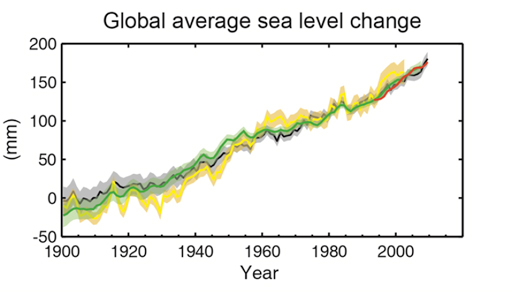9.2.2 Effects of rising global temperature on sea levels
Increased global temperature affects the amounts of snow, ice and glaciers that remain frozen. Several reports indicate that the frozen water in the northern hemisphere is melting faster than expected, particularly in the last two decades (IPCC, 2013). As you can see from Figure 9.2, there has been a sharp decrease since about 1960 in the extent of Arctic sea ice during the summer months and in the spring snow cover in the northern hemisphere. About 60–70% of Africa’s glaciers have also been lost since the early 1900s (UNEP, 2012).

When there is increased melting of polar ice sheets and snow cover, the melted water flows into the oceans and contributes to the long-term rising trend in global sea levels, shown in Figure 9.3. The global sea level has risen by an estimated 190 millimetres (mm) since the start of the 19th century.

Rising sea levels erode coastlines and allow seawater to flood inland, damaging coastal towns and cities.
What other effects will seawater flooding have on coastal communities and environments?
Sea water contaminates fresh water and soils with salt, which reduces the productivity of agricultural land, kills trees and destroys habitats for animals and plants. Salt damage to the environment causes shortages of food and fresh drinking water, leading to malnutrition, displacement of human populations and loss of biodiversity.
Global warming also increases the evaporation of surface water into the atmosphere, which in turn leads to changes in the patterns and intensity of rainfall in different parts of the world. Changes in rainfall cause an increase in floods in some regions and more frequent droughts in others. You will learn more about these changes and their effects on humans and the environment in Study Sessions 10 and 11. Next we discuss the causes of the global climate changes we have just described.
9.2.1 Global land and sea surface temperatures are rising
